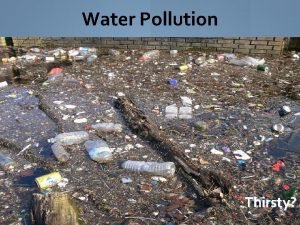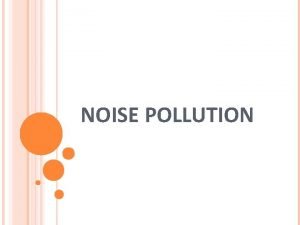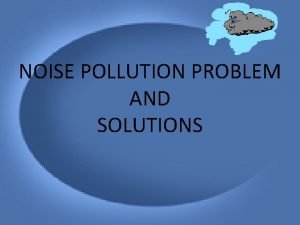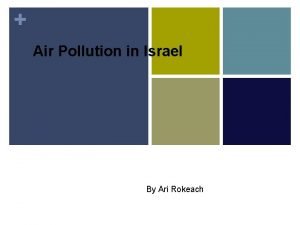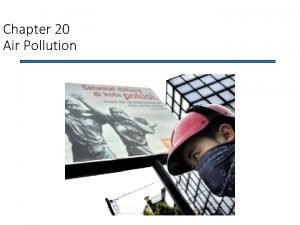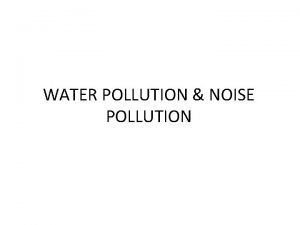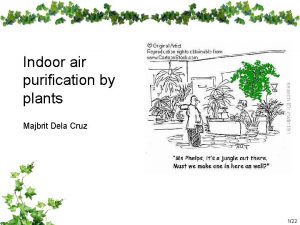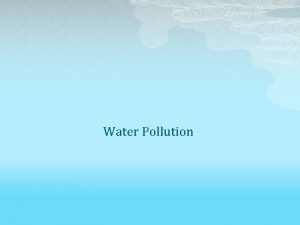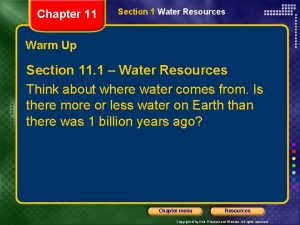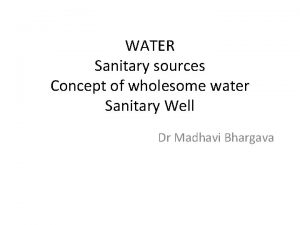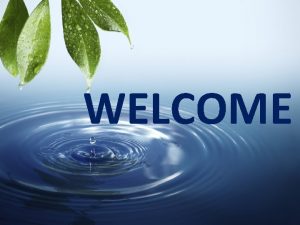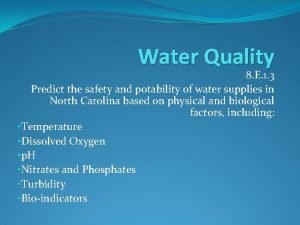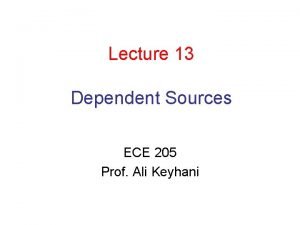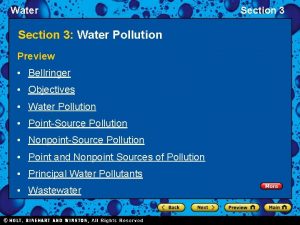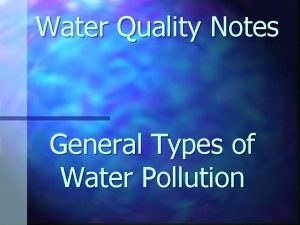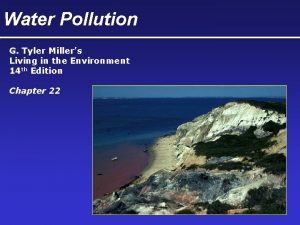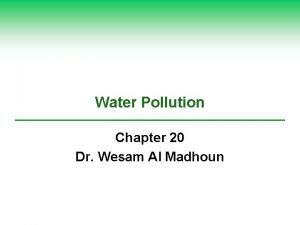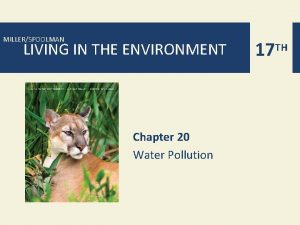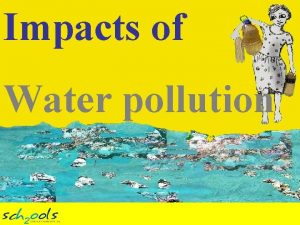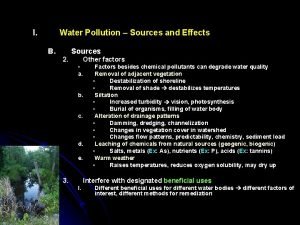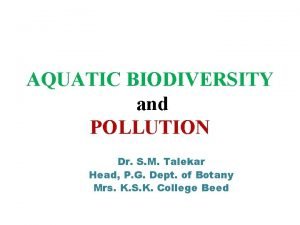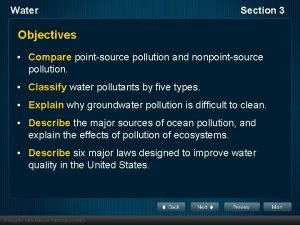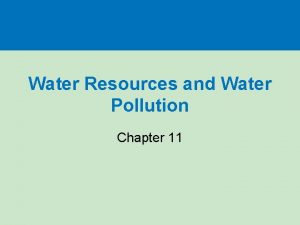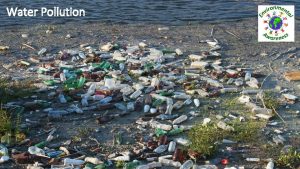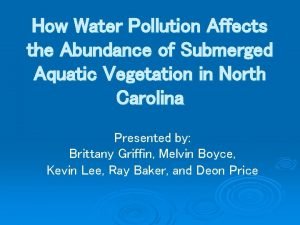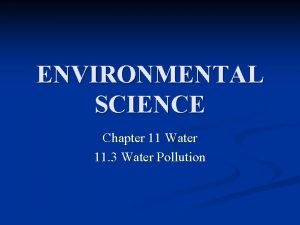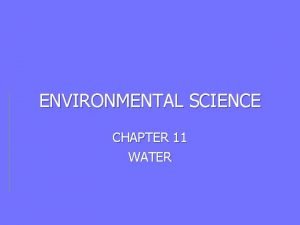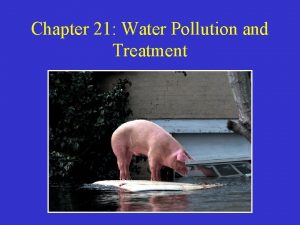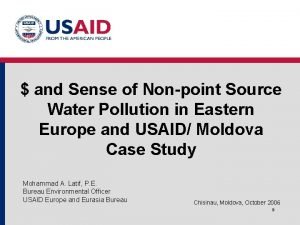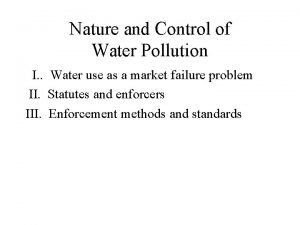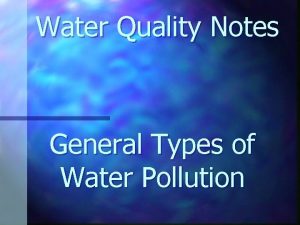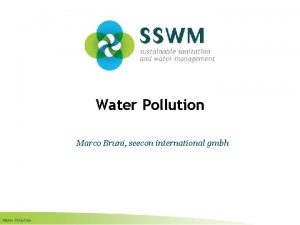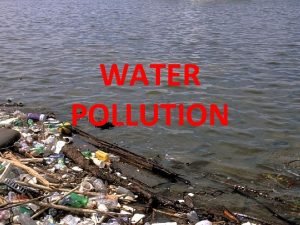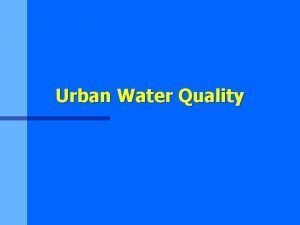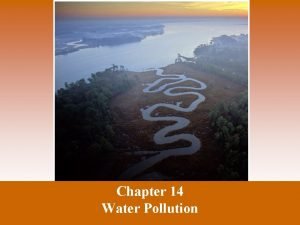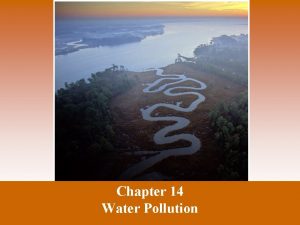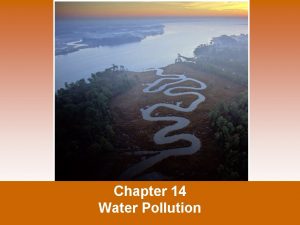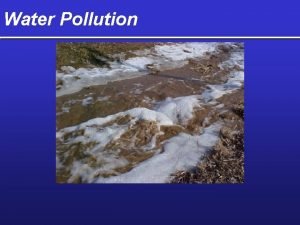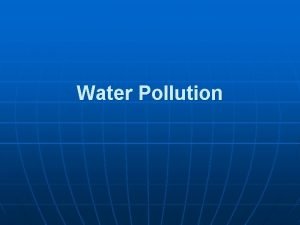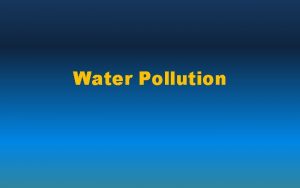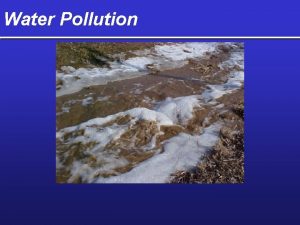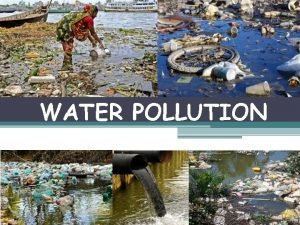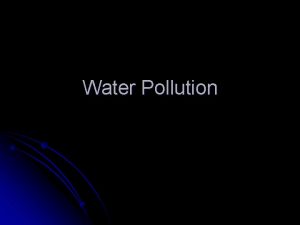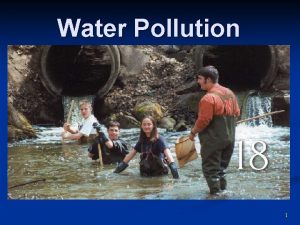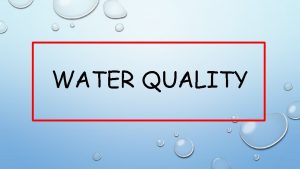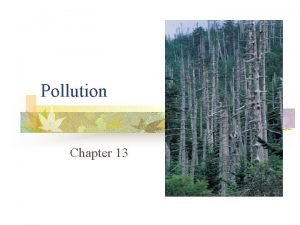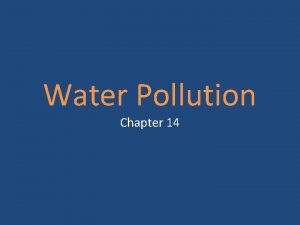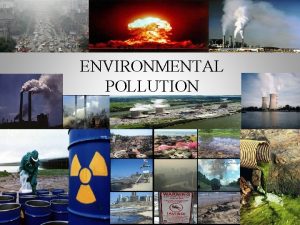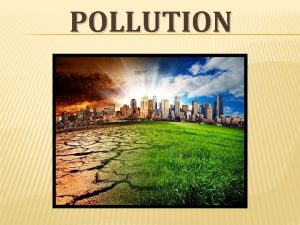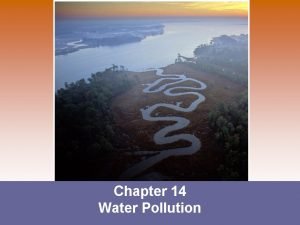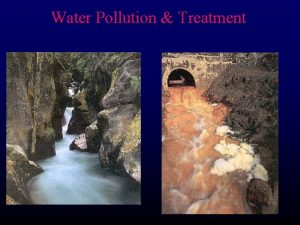Chapter 21 Water Pollution WATER POLLUTION SOURCES TYPES
















































- Slides: 48

Chapter 21 Water Pollution

WATER POLLUTION: SOURCES, TYPES, AND EFFECTS Ø Water pollution is any chemical, biological, or physical change in water quality that has a harmful effect on living organisms or makes water unsuitable for desired uses. l l Point source: specific location (drain pipes, ditches, sewer lines). Nonpoint source: cannot be traced to a single site of discharge (atmospheric deposition, agricultural / industrial / residential runoff)

Leading Sources of Water Pollution Ø Agriculture= leading cause of water pollution. Excess fertilizers, soil sediments from erosion, pesticides, animal wastes. Ø Industrial= Large inorganic and organic waste. Inorganic (acids, heavy metals, fertilizers) Organic (gasoline, volatile organic compounds) Ø Mining= release of harmful chemicals such as arsenic, cyanide, sulfuric acid

Table 21 -2, p. 495

Major Water Pollutants and Their Effects Ø A fecal coliform bacteria test is used to indicate the likely presence of disease -causing bacteria in water. Figure 21 -2

Major Water Pollutants and Their Effects Ø Water quality and dissolved oxygen (DO) content in parts per million (ppm) at 20°C. l Only a few fish species can survive in water less than 4 ppm at 20°C. Figure 21 -3

POLLUTION OF FRESHWATER STREAMS Ø Flowing streams can recover from a moderate level of degradable water pollutants if they are not overloaded and their flows are not reduced. l In a flowing stream, the breakdown of degradable wastes by bacteria depletes DO and creates and oxygen sag curve. • This reduces or eliminates populations of organisms with high oxygen requirements.

Water Pollution Problems in Streams Ø Dilution and decay of degradable, oxygen- demanding wastes and heat in a stream. Figure 21 -4

POLLUTION OF FRESHWATER STREAMS Ø Most developed countries have sharply reduced point-source pollution but toxic chemicals and pollution from nonpoint sources are still a problem. Ø Stream pollution from discharges of untreated sewage and industrial wastes is a major problem in developing countries.

Global Outlook: Stream Pollution in Developing Countries Ø Water in many of central China's rivers are greenish black from uncontrolled pollution by thousands of factories. Figure 21 -5

Case Study: India’s Ganges River: Religion, Poverty, and Health Ø Religious beliefs, cultural traditions, poverty, and a large population interact to cause severe pollution of the Ganges River in India. l l Very little of the sewage is treated. Hindu believe in cremating the dead to free the soul and throwing the ashes in the holy Ganges. • Some are too poor to afford the wood to fully cremate. • Decomposing bodies promote disease and depletes DO.

Case Study: India’s Ganges River: Religion, Poverty, and Health Ø Daily, more than 1 million Hindus in India bathe, drink from, or carry out religious ceremonies in the highly polluted Ganges River. Figure 21 -6

POLLUTION OF FRESHWATER LAKES Ø Dilution of pollutants in lakes is less effective than in most streams because most lake water is not mixed well and has little flow. l l Lakes and reservoirs are often stratified and undergo little mixing. Low flow makes them susceptible to runoff. Ø Various human activities can overload lakes with plant nutrients, which decrease DO and kill some aquatic species.

Cultural Eutrophication Ø Eutrophication: the natural nutrient enrichment of a shallow lake, estuary or slow moving stream, mostly from runoff of plant nutrients from the surrounding land. Ø Cultural eutrophication: human activities accelerate the input of plant nutrients (mostly nitrate- and phosphate-containing effluents) to a lake. l 85% of large lakes near major population centers in the U. S. have some degree of cultural eutrophication.

POLLUTION OF GROUNDWATER Ø Groundwater can become contaminated with a variety of chemicals because it cannot effectively cleanse itself and dilute and disperse pollutants. l The drinking water for about half of the U. S. population and 95% of those in rural areas comes from groundwater.

Polluted air Pesticides and fertilizers Coal strip mine runoff Hazardous waste injection well Deicing road salt Buried gasoline and solvent tanks Gasoline station Pumping well Water pumping well Waste lagoon Cesspool, septic tank Sewer Landfill Accidental spills Leakage from faulty casing r e d fr sh te wa r ife u q a ine f n ate o w c Un esh r f ed n i f n Co ifer u q ra Discharge Confined aquifer Groundwater flow Fig. 21 -7, p. 501

POLLUTION OF GROUNDWATER Ø It can take hundreds to thousand of years for contaminated groundwater to cleanse itself of degradable wastes. l l Nondegradable wastes (toxic lead, arsenic, flouride) are there permanently. Slowly degradable wastes (such as DDT) are there for decades.

Leaking tank Aqu ifer Water table Bed rock Groundwater flow Free gasoline dissolves in Gasoline leakage plume groundwater (dissolved (liquid phase) Migrating vapor phase Contaminant plume moves with the groundwater Water well Fig. 21 -8, p. 502

POLLUTION OF GROUNDWATER Ø Leaks from a number of sources have contaminated groundwater in parts of the world. l l According the EPA, one or more organic chemicals contaminate about 45% of municipal groundwater supplies. By 2003, the EPA had completed the cleanup of 297, 000 of 436, 000 underground tanks leaking gasoline, diesel fuel, home heating oil, or toxic solvents.

Case Study: Arsenic in Groundwater a Natural Threat Ø Toxic Arsenic (As) can naturally occur at high levels in soil and rocks. Ø Drilling into aquifers can release As into drinking water supplies. Ø According to WHO, more than 112 million people are drinking water with As levels 5100 times the 10 ppb standard. l Mostly in Bangladesh, China, and West Bengal, India.

Solutions Groundwater Pollution Prevention Find substitutes for toxic chemicals Keep toxic chemicals out of the environment Install monitoring wells near landfills and underground tanks Require leak detectors on underground tanks Ban hazardous waste disposal in landfills and injection wells Store harmful liquids in aboveground tanks with leak detection and collection systems Cleanup Pump to surface, clean, and return to aquifer (very expensive) Inject microorganisms to clean up contamination (less expensive but still costly) Pump nanoparticles of inorganic compounds to remove pollutants (may be the cheapest, easiest, and most effective method but is still being developed) Fig. 21 -9, p. 504

OCEAN POLLUTION Ø Oceans, if they are not overloaded, can disperse and break down large quantities of degradable pollutants. Ø Pollution of coastal waters near heavily populated areas is a serious problem. l l About 40% of the world’s population lives near on or near the coast. The EPA has classified 4 of 5 estuaries as threatened or impaired.

Industry Nitrogen oxides from autos and smokestacks, toxic chemicals, and heavy metals in effluents flow into bays and estuaries. Cities Toxic metals and oil from streets and parking lots pollute waters; Urban sprawl Bacteria and viruses from sewers and septic tanks contaminate shellfish beds Construction sites Sediments are washed into waterways, choking fish and plants, clouding waters, and blocking sunlight. Farms Runoff of pesticides, manure, and fertilizers adds toxins and excess nitrogen and phosphorus. Closed shellfish beds Closed beach Toxic sediments Chemicals and toxic metals contaminate shellfish beds, kill spawning fish, and accumulate in the tissues of bottom feeders. Oxygen-depleted zone Sedimentation and algae overgrowth reduce sunlight, kill beneficial sea grasses, use up oxygen, and degrade habitat. Red tides Excess nitrogen causes explosive growth of toxicmicroscopic algae, poisoning fish and marine mammals. Healthy zone Clear, oxygen-rich waters promote growth of plankton and sea grasses, and support. Fig. fish. 21 -10, p. 505

OCEAN POLLUTION Ø Harmful algal blooms (HAB) are caused by explosive growth of harmful algae from sewage and agricultural runoff. Figure 21 -11

Oxygen Depletion in the Northern Gulf of Mexico Ø A large zone of oxygendepleted water forms for half of the year in the Gulf of Mexico as a result of HAB. Figure 21 -A

Missouri River Mississippi River Basin Ohio River Mississippi River LA MS TX LOUISIANA Mississippi River Depleted oxygen Gulf of Mexico Fig. 21 -A, p. 507

Case Study: The Chesapeake Bay – An Estuary in Trouble Ø Pollutants from six states contaminate the shallow estuary, but cooperative efforts have reduced some of the pollution inputs. Figure 21 -12

Chesapeake Bay Largest estuary in the United States. Ø Phosphate pollution comes from sewage and treatment plants Ø Nitrate pollution comes from runoff of fertilizers, animal waste from agriculture, urban, suburban land. Ø Lox oxygen levels population of important species have declined Ø Government land use regulations and banning of phosphate material, upgrading sewage treatment plants have aided the healing process. Ø

OCEAN OIL POLLUTION Ø Most ocean oil pollution comes from human activities on land. l l Studies have shown it takes about 3 years for many forms of marine life to recover from large amounts of crude oil (oil directly from ground). Recovery from exposure to refined oil (fuel oil, gasoline, etc…) can take 10 -20 years for marine life to recover.

OCEAN OIL POLLUTION Ø Tanker accidents and blowouts at offshore drilling rigs can be extremely devastating to marine life (especially diving birds, left). Figure 21 -13

Solutions Coastal Water Pollution Prevention Reduce input of toxic pollutants Cleanup Improve oil-spill cleanup capabilities Separate sewage and storm lines Ban dumping of wastes and sewage by maritime and cruise ships in coastal waters Ban ocean dumping of sludge and hazardous dredged material Sprinkle nanoparticles over an oil or sewage spill to dissolve the oil or sewage without creating harmful by-products (still under development) Protect sensitive areas from development, oil drilling, and oil shipping Require at least secondary treatment of coastal sewage Regulate coastal development Recycle used oil Use wetlands, solar-aquatic, or other methods to treat sewage Require double hulls for oil tankers Fig. 21 -14, p. 509

PREVENTING AND REDUCING SURFACE WATER POLLUTION Ø The key to reducing nonpoint pollution – most of it from agriculture – is to prevent it from reaching bodies of water. l Farmers can reduce runoff by planting buffers and locating feedlots away from steeply sloped land, flood zones, and surface water.

PREVENTING AND REDUCING SURFACE WATER POLLUTION Ø Most developed countries use laws to set water pollution standards, but such laws rarely exist in developing countries. l l The U. S. Clean Water Act sets standards fro allowed levels of key water pollutants and requires polluters to get permits. EPA is experimenting with a discharge trading policy similar to that for air pollution control.

Reducing Water Pollution through Sewage Treatment Ø Septic tanks and various levels of sewage treatment can reduce point-source water pollution. Figure 21 -15

Manhole cover (for cleanout) Septic tank Gas Distribution box Scum Wastewater Sludge Drain field (gravel or crushed stone) Vent pipe Perforated pipe Fig. 21 -15, p. 510

Reducing Water Pollution through Sewage Treatment Ø Raw sewage reaching a municipal sewage treatment plant typically undergoes: l l Primary sewage treatment: a physical process that uses screens and a grit tank to remove large floating objects and allows settling. Secondary sewage treatment: a biological process in which aerobic bacteria remove as much as 90% of dissolved and biodegradable, oxygen demanding organic wastes.

Reducing Water Pollution through Sewage Treatment Ø Primary and Secondary sewage treatment. Figure 21 -16

Reducing Water Pollution through Sewage Treatment Ø Advanced or tertiary sewage treatment: l Uses series of chemical and physical processes to remove specific pollutants left (especially nitrates and phosphates). Ø Water is chlorinated to remove coloration and to kill disease-carrying bacteria and some viruses (disinfect).

Reducing Water Pollution through Sewage Treatment Ø Sewage sludge can be used as a soil conditioner but this can cause health problems if it contains infectious bacteria and toxic chemicals. Ø Preventing toxic chemicals from reaching sewage treatment plants would eliminate such chemicals from the sludge and water discharged from such plants.

Dust Particles of dried sludge carry viruses and harmful bacteria that can be inhaled, infect cuts or enter homes. Odors may cause illness or indicate presence of harmful gases. BUFFER ZONE Sludge Groundwater Contamination Harmful chemicals and pathogens may leach into groundwater and shallow wells. Exposure Children may walk or play in fertilized fields. Livestock Poisoning Cows may die after grazing on sludge-treated fields. Surface Runoff Harmful chemicals and pathogens may pollute nearby streams, lakes, ponds, and wetlands. Fig. 21 -17, p. 513

Reducing Water Pollution through Sewage Treatment Ø Natural and artificial wetlands and other ecological systems can be used to treat sewage. l California created a 65 hectare wetland near Humboldt Bay that acts as a natural wastewater treatment plant for the town of 16, 000 people. • The project cost less than half of the estimated price of a conventional treatment plant.

Reducing Water Pollution through Sewage Treatment Ø Water pollution laws have significantly improved water quality in many U. S. streams and lakes but there is a long way to go. Ø Some want to strengthen the U. S. Clean Water Act (CWA) to prevent rather than focusing on end-of-the-pipe removal. Ø Many farmers and developers see the CWA as limiting their rights as property owners to fill in wetlands.

DRINKING WATER QUALITY Ø Centralized water treatment plants and watershed protection can provide safe drinking water for city dwellers in developed countries. Ø Simpler and cheaper ways can be used to purify drinking water for developing countries. l Exposing water to heat and the sun’s UV rays for 3 hours can kill infectious microbes.

Using Laws to Protect Drinking Water Ø While most developed countries have drinking water quality standards and laws, most developing countries do not. Ø The U. S Safe Drinking Water Act requires the EPA to establish national drinking water standards (maximum contaminant levels) for any pollutant that may have adverse effects on human health.

Using Laws to Protect Drinking Water Ø The U. N. estimates that 5. 6 million Americans drink water that does not meet EPA standards. Ø 1 in 5 Americans drinks water from a treatment plant that violated one or more safety standard. Ø Industry pressures to weaken the Safe Drinking Act: l l Eliminate national tests and public notification of violations. Allow rights to pollute if provider cannot afford to comply.

Is Bottled Water the Answer? Ø Some bottled water is not as pure as tap water and costs much more. l l 1. 4 million metric tons of plastic bottles are thrown away. Fossil fuels are used to make plastic bottles. • The oil used to produce plastic bottles in the U. S. each year would fuel 100, 000 cars.

Solutions Water Pollution • Prevent groundwater contamination • Reduce nonpoint runoff • Reuse treated wastewater for irrigation • Find substitutes for toxic pollutants • Work with nature to treat sewage • Practice four R's of resource use (refuse, reduce, recycle, reuse) • Reduce air pollution • Reduce poverty • Reduce birth rates Fig. 21 -18, p. 517

What Can You Do? Water Pollution • Fertilize garden and yard plants with manure or compost instead of commercial inorganic fertilizer. • Minimize your use of pesticides. • Do not apply fertilizer or pesticides near a body of water. • Grow or buy organic foods. • Do not drink bottled water unless tests show that your tap water is contaminated. Merely refill and reuse plastic bottles with tap water. • Compost your food wastes. • Do not use water fresheners in toilets. • Do not flush unwanted medicines down the toilet. • Do not pour pesticides, paints, solvents, oil, antifreeze, or other products containing harmful chemicals down the drain or onto the ground. Fig. 21 -19, p. 517
 Water resources important
Water resources important Major source of water pollution
Major source of water pollution Print sources of information
Print sources of information Water and water and water water
Water and water and water water Source of contamination
Source of contamination Solutions to noise pollution
Solutions to noise pollution Issue of noise pollution
Issue of noise pollution Stationary and mobile sources of air pollution
Stationary and mobile sources of air pollution Sources of smog
Sources of smog Example of noise pollution
Example of noise pollution Define mobile sources of air pollution
Define mobile sources of air pollution Indoor air pollutants
Indoor air pollutants Source of thermal pollution
Source of thermal pollution Types of water pollution
Types of water pollution Water pollution
Water pollution Chapter 11 section 2 water use and management
Chapter 11 section 2 water use and management Sanitary well features
Sanitary well features 10 sources of water
10 sources of water Sources of water
Sources of water Predict the sources of water
Predict the sources of water Node voltage analysis with dependent sources
Node voltage analysis with dependent sources Examples of graphic sources
Examples of graphic sources Chapter 2 income sources
Chapter 2 income sources Class 8 english chapter 7 water water everywhere
Class 8 english chapter 7 water water everywhere Section 3 water pollution
Section 3 water pollution Type of reefs
Type of reefs What are the terrible twelve water pollution
What are the terrible twelve water pollution Solutions to water pollution
Solutions to water pollution 2 causes of soil pollution
2 causes of soil pollution Control measures of noise pollution
Control measures of noise pollution Land water and air pollution
Land water and air pollution Methods of water pollution
Methods of water pollution Effects of water pollution
Effects of water pollution Ddt water pollution
Ddt water pollution What are 5 effects of water pollution?
What are 5 effects of water pollution? Objectives of water pollution
Objectives of water pollution How to overcome water pollution
How to overcome water pollution Conclusion of water pollution
Conclusion of water pollution Why is water pollution a great concern in southwest asia
Why is water pollution a great concern in southwest asia Summary of water pollution
Summary of water pollution Objective of water pollution
Objective of water pollution Chapter 11 review environmental science
Chapter 11 review environmental science Introduction of water pollution
Introduction of water pollution Observation of river pollution
Observation of river pollution Site:slidetodoc.com
Site:slidetodoc.com High level of pollution
High level of pollution Ssswm
Ssswm Conclusion on pollution for school project
Conclusion on pollution for school project Water pollution
Water pollution

